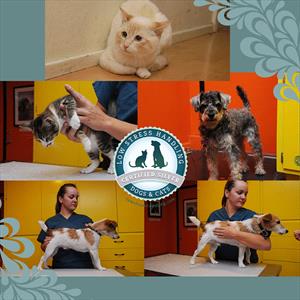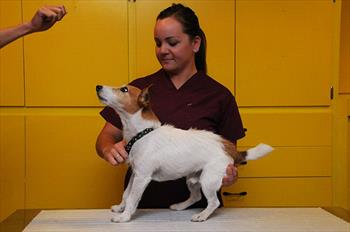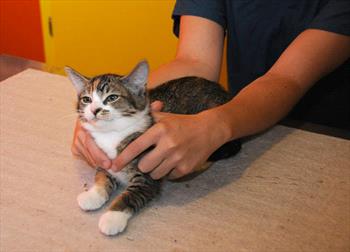Questions of the Day for the week of August 11th-14th
We posted a series of pictures with questions on Facebook and we got some great answers. How did you do with your answer? Test yourself!
Question:
This cat has come for its first visit and spends most of the visit in this position. Is the cat relaxed or anxious? Explain.
Answer:
A comfortable cat should explore the room. This cat is stationary with tail tucked and feet tucked into his body because he’s nervous. This behavior is a form of freezing.
Question:
You enter the exam room and this dog is barking at you while wagging his tail. Does the wagging tail mean that the dog is friendly? Explain.
Answer:
A wagging tail indicates the dog is excited, not necessarily friendly. Dogs can wag their tails like this when they have no friendly intentions such as just before chasing a cat or a squirrel.
Question:
Which of these holds controls movement of the front end in more directions: the arm-around-the-chest hold or the collar hold? (And what directions of movement does each hold control?) Note that this dog is being lured forward by someone holding treats.
Answer:
While the arm-around-the-chest hold involves a greater surface area of coverage, it controls only left, right, forward and down. A dog can still jump up or step over the arm. The collar hold controls movement left, right, forward, down and up.
Question:
Without scruffing, boxes or bags, a towel wrap, or clipnosis, how can you restrain a cat in a way that controls movement in all six directions without increasing the cat’s stress and arousal?
Answer:
Place a loose ring hold around the neck to control movement of the front end in five directions (right, left, forward, up and down) and position your arms such that they are ready to form a wall along each side of the cat. Your body can be behind the cat in a position to prevent backwards movement as needed. Avoid squeezing the cat or rigidly holding the cat in place, since this often causes cats to struggle more. Instead, if the cat moves to try to escape, move slightly with the cat’s movement while still providing a barrier to escape with your hands, arms and body. See example.





